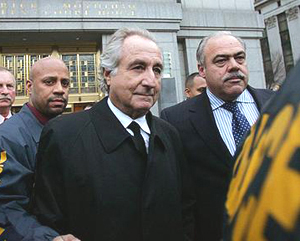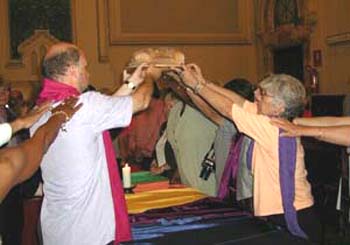 |
Consequences of Vatican II
Progressivism's Big Con
Lyle J. Arnold, Jr.
The well-known cliché "con-man" is rooted in the word "confidence," whereby a swindle takes place by first gaining the confidence of a victim. In the criminal world of flimflam, bunco, grifters, hustlers and other assorted con artists, their repertoire of schemes – worked on the "mark" (the victim) and executed in the "sting" (the deceptive operation) - is ageless and almost endless.

"Big con" man Bernard Madoff pleaded guilty on March 12, 2009, to 11 charges related to fraud |
In classic cons, however, there are only two camps, the big con and the short con. The big con is a confidence game of epic proportions with a large take. A big con game, for example, is the Ponzi scheme orchestrated by Bernard Madoff that snared millions of dollars from his “marks.” The short con is any simple confidence game or trick involving a relatively small amount of money. Clearly, Catholics across the globe have been the marks of the biggest con in History.
Our story opens with Hans Urs von Balthasar, considered one of the most important theologians of the 20th century. Von Balthasar left the Jesuits and was banned from teaching by the Church in 1950. John Paul II, however, resuscitated him from dishonor and promoted him to Cardinal. Hans died two days before the ceremony, and then-Cardinal Ratzinger validated his heretical writings at the funeral as being "right in what he teaches of the faith."(1)
In a tract of his writings that is "full of sound and fury, signifying nothing" (as Shakespeare said), Hans argues that the Church must die out of obedience. In Chapter V of the new release Ecclesia, author Atila Guimaraes notes:
"Von Balthasar again expounds on the ideal of the Servant Church, presenting Christ speaking mystically to the Church. ‘Become my servant, renounce your own will ... and become obedient even to death ... I abandon you to the world ... I leave you emptied of your soul in the sepulcher of the world, with your spirit wandering in the shadows of hell..."(3)
These words by Hans are poetic and heretical theses constituting an absurd contradiction to the vocation Our Lord gave the Church to go out and "teach all nations" (Mt 28: 19). Nonetheless, following the spirit of Vatican II, von Balthasar promotes a notion of the Servant Church that would justify the self-destruction of the Church.
According to him, the Church should concretely imitate the Redeemer in His Passion, and relinquish her sanctity, power and majesty, embrace an ignominious death, and after that, descend into Hell in solidarity with the reprobates. It is the progressivist theory of kenosis and a fundamental theme of von Balthasar, who insists on the “crucifixion of the Church.” (2)
Guimarães ends the chapter with this indictment: "Thus, according to the theologians cited above, among many others, the principal end of the Servant Church of Vatican II is her self-immolation. In more direct terms, the concept of the Servant Church is a powerful means to destroy the Holy Catholic Church, Queen of peoples and nations." (3)
Von Balthasar's dribble - that the Church should be suicidal - is so senseless as to be demented. Instead of a Catholic Church that fights for the Triune God, dear reader, because, as Holy Scripture says, she is “as terrible as an army set in battle array” by institution of Jesus Christ, von Balthasar depicts a Church that is insipid and whimpering and dying.
When the argument of authority becomes fraudulent
Every Catholic worthy of the name has been asking two questions about the revolutionary crisis in the Church year after year since Vatican II: "How did it all happen? When will it end?"
As to the first question, I place before the reader a hypothesis: that the destruction of the Church was generated by an old strategy resurrected by the progressivist conciliar fathers. This strategy is the big con of destroying the Church by the appeal to conscience and obedience. As to the second question, we have confidence in the promise Our Lady gave us at Fatima and Quito that in the end, she will intervene and triumph.
This strategy of using violence upon consciences – similar to that used by the Pharisees in the Gospel - was the perfect formula after Vatican II to make progressivists out of Catholics. The Vatican II fathers had a global captive audience upon which to work their con. Because of the confidence of the faithful in the Church – which was at a high point at that time - the big con was easy to use on the "marks," the rank-and-file Catholics.
For example, at that time the majority of Catholics took the Sunday obligation to assist at Mass very seriously. The situation was made-to-order to destroy the Faith vis-a-vis replacing the Tridentine Mass with its emphasis on sacrifice and sacrality with the Novus Ordo and the spirit of the Council. To question this new liturgy, for most Catholics, was considered tantamount to a betrayal of their principles. Following the words of St. Thomas, we believed that nothing born in disobedience would bear fruit.

Every imaginable abuse has been accepted in the name of obedience... |
A few, however, began to see through this strategy of employing the traditional notions of Church obedience to undermine resistance to the destruction of Tradition inside the Church. As an outdated priest looking at the modern Church would say:
"Agonizingly we began to do the heretofore unthinkable. We began to question how developments born in disobedience, such as Communion in the hand and altar girls, could be institutionalized by the very superiors who never missed an opportunity to remind us of our duty to obey."(4)
There is a name for the strategy of using the force of conscience and the notion of obedience to undermine the Faith. It is one of the 11 fallacies of relevance called argumentum ad verecundiam (the fallacy of appealing to the teaching of an authority outside his special field). And it has worked. Its success is evident everywhere.
There is, however, a significant remnant of Catholics who have discerned the nuanced outcome, that these developments born in disobedience in fact expose the guilt of the progressivists that has destroyed the faith of so many. To use the words of St. Jerome, "The whole world groaned, and was astonished to find itself Arian." Today, except for a remnant, the whole Catholic world is progressivist.
Those readers of Tradition in Action who are in agreement with its Manifesto of Resistance and follow its banner do not need a list of Catholic indicators to be convinced about the crisis in today's Church, "born in disobedience."
1. John Allen, Jr., "The Word From Rome," National Catholic Reporter, 11-28-033 2.
2. Guimaraes examines the progressivist doctrine of kenosis in more detail in Chapter II of Volume IV of his Collection, Animus Delendi I (Desire to Destroy I), pp. 85-106.
3. Ecclesia, Volume XI Collection Eli, Eli, lamma sabacthani, (Los Angeles: Tradition in Action, 2009), p. 229.
4. Marc Tully, "An Outdated Priest Looks at his Modern Church," The Latin Mass, Spring 2000, pp. 26-27.

Posted August 26, 2009

Related Topics of Interest
 When Love for the Church Disappears When Love for the Church Disappears
 Examining the Mystery of God’s Church Examining the Mystery of God’s Church
 The Laws of Thought and the Heresy of Progressivism The Laws of Thought and the Heresy of Progressivism
 The Growing Rejection of Vatican II The Growing Rejection of Vatican II
 Question & Answers about the Collection: Eli, Eli, Lamma Sabacthani Question & Answers about the Collection: Eli, Eli, Lamma Sabacthani
 Resistance vs. Sede-Vacantism Resistance vs. Sede-Vacantism
 Is Sede-Vacantism an Ally of Progressivism? Is Sede-Vacantism an Ally of Progressivism?

Related Works of Interest
|
|
Vatican II | Hot Topics | Home | Books | CDs | Search | Contact Us | Donate

© 2002-
Tradition in Action, Inc. All Rights Reserved
|
 |
|